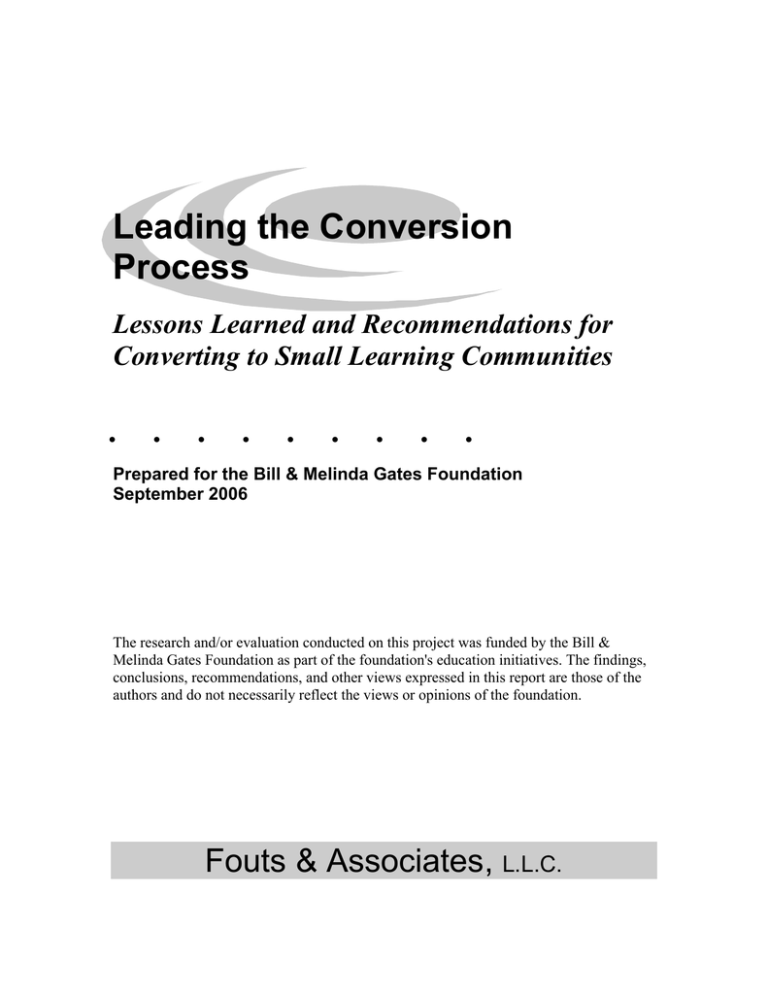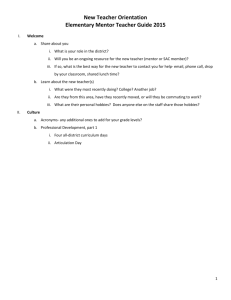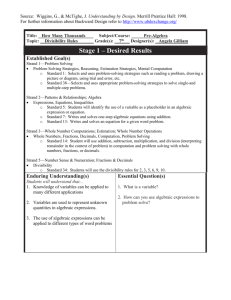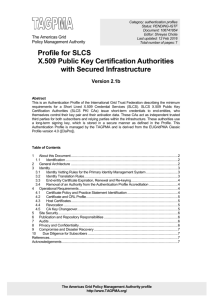Leading the Conversion Process: Lessons Learned and
advertisement

Leading the Conversion Process Lessons Learned and Recommendations for Converting to Small Learning Communities • • • • • • • • • Prepared for the Bill & Melinda Gates Foundation September 2006 The research and/or evaluation conducted on this project was funded by the Bill & Melinda Gates Foundation as part of the foundation's education initiatives. The findings, conclusions, recommendations, and other views expressed in this report are those of the authors and do not necessarily reflect the views or opinions of the foundation. Fouts & Associates, L.L.C. Leading the Conversion Process Lessons Learned and Recommendations for Converting to Small Learning Communities • • • • • • • • • Jeffrey T. Fouts Duane B. Baker Carol J. Brown Shirley C. Riley Fouts & Associates, L.L.C. Introduction Leading the Conversion Process Lessons Learned and Recommendations for Converting to Small Learning Communities INTRODUCTION Over the last 10 years, educators, policy makers, and the public have become dissatisfied with the product of American high schools. Calls for reforms have increased, and some educators have responded with attempts to implement smaller learning communities (SLCs) to increase student involvement, learning, and graduation rates. Many high schools across the country are actively working to implement SLCs, while others have completed the conversion process with varying degrees of success. The comprehensive high school model and supporting philosophy is an institutionalized and entrenched element of the American educational system, and converting these schools to multiple smaller learning communities is proving to be a difficult task. In fact, even when educators have been successful at implementing SLCs, recent research has shown that the educational benefits generally associated with smaller schools are not clear. For example, researchers in Chicago 1 and elsewhere 2 found affective differences in the school environments but no clear impact on student learning. Researchers have also found that the process of converting a comprehensive high school to SLCs can be very disruptive to the school and that the efforts may or may not be successful 3 . While researchers continue to study effects of small schools and SLCs on student outcomes, in this paper we are focusing on what we have learned about the actual process of converting comprehensive high schools to SLCs. Since 2001, the Bill & Melinda Gates Foundation has funded the development of small learning communities in America’s high schools with the ultimate goal of graduating students “college or work ready.” There have been two major approaches to this work: the creation of new schools of limited size and the conversion of large, 1 Kahne, Joseph, Susan Porte, Marisa de la Torre, with John Easton, (June, 2006). Small high schools on a larger scale: The first three years of the Chicago High School Redesign Initiative. Consortium on Chicago School Research at the University of Chicago. 2 Rhodes, David, Becky Smerdon, Winona Burt, Aimee Evan, Ben Martinez, and Barbara Means (2005). Getting results: Student outcomes in new and redesigned high schools. American Institutes for Research and SRI International. Baker, Duane, Candace Gratama, Heather Stroh, Jeffrey Fouts, and Shawn Bachtler (January 2005). The Bill & Melinda Gates Foundation’s Washington State Achievers high schools: Year 3 evaluation summary. Fouts & Associates. 3 Baker, et al. (2005). Colorado Small School Initiative at the Colorado Children’s Campaign (2005). Breaking up is hard to do: Lessons Learned from the experiences of Manual High School. Author. Small Schools Project (2005). Redesigning our high schools: Five years of small schools work in Washington State. Author. September 2006 • 1 Introduction comprehensive high schools into multiple small learning communities of 400 or fewer students. SLCs are often called houses, schools-within-a-school, or academies and have varying degrees of autonomy in the areas of budgets, hiring, and curriculum. Fouts & Associates, a group of independent evaluators and researchers, has served as one of the foundation’s evaluation agents for converting large high schools into SLCs. Since 2001, we have evaluated grants involving over 40 high schools in Washington State, North Carolina, Oregon, and Missouri that are in the process or have completed the conversion process. Our evaluations resulted in over 100 reports and updates to the foundation describing the processes, struggles, and successes of these schools. In addition, some in Fouts & Associates have evaluated 15 U.S. Department of Education Smaller Learning Communities grants over the last few years. This report is a brief synthesis of our evaluation findings and highlights the important lessons and recommendations for current and future efforts for converting to small learning communities. 2 • Fouts & Associates Lessons Learned LESSONS LEARNED: WHAT WORKED AND WHAT DID NOT 1. The schools most successful at converting to SLCs focused considerable attention on a “moral imperative” to change their practices to better serve their students. To do this, they often relied heavily on test scores, graduation rates, and dropout rates disaggregated by race and ethnicity to bring a focus to the limitations of the current school model and to the need for change. This process was instrumental in bringing to the surface teachers’ attitudes and beliefs about their students and the goals of schooling. It was also a way to obtain the support of the school board and the public. Many teachers and parents are actually unaware of their school’s statistics on dropout rates, graduation rates, and other important student outcomes. It is often not enough to point to state or national averages because local changes must be based on locally perceived situations of “why change?” Some schools used elaborate systems to provide the data, involving student tracking and detailed reports although this was not always the case. Some schools used more personal strategies to create awareness of the number of students who “fall through the cracks.” Tracking a 9th grade cohort using yearbooks can be used to actually see the number of students who “disappear” from school before graduation. It is a powerful and personal way to illustrate the need for a school to change. Whether schools use an informal strategy such as this yearbook exercise or an elaborate student tracking system, school conversions stand a better chance of success when there is a strong moral imperative to better serve the students. During our evaluation activities, we interviewed hundreds of teachers about education in general and about SLCs in particular. In those schools where a moral imperative was the impetus for change and where a majority of teachers believed in their students’ inherent ability to learn and the importance of high standards for all students, the structural changes came more smoothly. In those schools where a majority of teachers did not share these beliefs, we found continued support for a comprehensive high school approach, which is contrary to the SLC philosophy of high rigor, high expectations, and high outcomes for all students. For example, we found many teachers believed strongly in having two separate programs: an academic track and a vocational track. These teachers believed, sometimes stated in the privacy of an interview, that there are students who are not capable or interested in college. There were even comments suggesting that while there were many students interested in college, their aspirations were unrealistic. In fact, these high school teachers were not convinced that the students, with the exception of high ability students in advanced courses, could succeed in college. Even though these teachers may have voted “yes” on receiving the grant, once the beliefs and implications underlying the SLCs became clear, they often openly resisted the changes or subverted the conversion process in a variety of ways. September 2006 • 3 Lessons Learned 2. Structural changes leading to SLCs do not necessarily result in improved instruction or increased student outcomes. For the changes to be truly meaningful, educators must always view the SLCs as a means to an end, and not an end unto itself. In many schools we evaluated, the conversion process proved to be much more difficult than almost anyone anticipated. In fact, educators expended so much energy and political capital on creating the SLCs that there was little time or energy left to focus on the reasons SLCs are desirable—to allow for a more personalized learning experience for students, to improve relationships between students and teachers, and to allow for improved instruction. Unfortunately, in many schools we found that several years into the process the educators were still focusing on schedules, teacher assignments, or parental discontent, with scant or no attention being given to matters that might improve the educational experience for students. In struggling with the structure, and often with other adults, educators often lost track of why they were changing the structure. In the most successful schools, educators gave continual efforts to the reasons to change, to a new education philosophy, and to instructional improvements. In short, the most successful schools maintained a clear vision of why they were changing the structure, and this clarity led them to focus on a wide range of professional growth activities. Unless teacher beliefs about student abilities, student learning, and the goals of education are exposed and addressed, then no structural change or program, such as SLCs, will make a difference. We found that where teachers believed in the ideas underlying the SLCs, the structural change process went more smoothly. Where the majority of teachers did not share these beliefs, the conversion process often led to extensive turmoil and strife. For this reason, unless the staff is ready, willing, and able to make this commitment, top-down mandates of changes to SLCs are extremely difficult to implement, and even if the structural changes are made, there is little reason to expect those changes will lead to improved student outcomes. 3. The implementation of SLCs affects teachers at least as much as it does students. SLCs require changes in the working environment and can affect teachers’ careers, both of which must be planned for and dealt with carefully. Changes in the Work Environment The research on the importance of a personalized learning environment to improved student outcomes is extensive and is the reason why it is desirable to create small learning communities. Additionally, strong teacher collaboration is essential. However, true teacher collaboration results from a mindset on the part of the teachers and not just from common time allotted for planning. The relationships necessary for SLCs to work as a means to an end require that adults move from working in isolation in their classrooms to working collaboratively with each other. This is a very different professional environment than most teachers have experienced previously. The change in the professional mindset of the teachers and sustained collaboration time in the most 4 • Fouts & Associates Lessons Learned successful schools was pervasive and resulted in more personalization for students. This requires careful planning and extensive professional development. Without these, the conversion process was greatly handicapped. Threats to Careers The successful implementation of SLCs threatened many teachers apart from the required changes in the work environment, beliefs and attitudes. Teachers come to realize that SLCs and the underlying ideas lead to changes in the focus of the schools, resulting in teacher reassignments, transfers, and even the loss of jobs. SLCs are often associated with increases in rigor and graduating all students “college or work ready,” particularly in the case of the Gates grantee schools. In practice, this increase in rigor meant the reduction or elimination of many elective and lower track courses, such as home economics and remedial math, and the addition of other courses, such as more foreign languages. “College ready” implies the elimination of not only vocational elective courses, but also the elimination of entire graduation “tracks” or separate diplomas, particularly in the vocational fields. Additionally, individual SLCs with small faculties cannot offer all the elective choices of comprehensive high schools, further limiting or eliminating certain course offerings. As the process develops, initial agreement among teachers to move into SLCs can soon be replaced by tremendous anxiety and outright opposition as the implications for job assignment and job continuation are realized. Understandably, we saw the perceived value of the SLCs wane as it became clear to some teachers how they or their colleagues would fare under such an arrangement. Where the leadership ignored these real concerns among teachers, turmoil often ensued. The most successful schools acknowledged and dealt with such reactions through personal career counseling with the affected teachers, arrangements for transfers to other schools, and understandings with the teachers’ union. 4. Successful conversion to SLCs requires a sustained commitment by the school district. Board members and district administrators must understand and support not only the structural changes being attempted but also must believe in the type of educational experience the structural changes are meant to create. In our evaluation work in conversion schools, we found that virtually all school boards and central office administrations had “signed off” on the grant and grant requirements. In fact, it was generally a requirement to receive the funding. However, as teachers in several schools pointed out to us, “signing off” to get the money was not the same as “signing on” to the philosophy underlying SLCs. As the conversion process moved forward, districts often “put on the brakes” or limited conversion once the implications for school autonomy involving budgeting and hiring, electives, AP, and other traditional practices became fully clear. In some cases, several years of work were lost and retrenchment began because the full impact of SLCs on traditional practices were not made clear initially. Support became even less evident where districts anticipated September 2006 • 5 Lessons Learned bond or levy elections and were concerned that high school redesign might lessen overall public support for the district. 5. Successful conversion requires an ongoing effort to ensure community awareness and support. Without these, the conversion process will be very difficult if not impossible. In fact, resistance to conversion to SLCs can be at least as strong among the public as it can be among teachers, particularly when parents discover that their son or daughter will no longer be in AP classes or in the gifted track. The most successful schools have involved the public in the planning process, particularly in the moral imperative discussions. At the outset, educators considering converting to SLCs must create an understanding of the need for high school reform; without such understanding, many parents and community members recall their own high school experiences: “It was good enough for me. Why isn’t it good enough for my child?” In addition, the parents of children who are the most successful in the current school model are often the ones most involved in and aware of the school’s activities. Awareness and understanding builds the political capital schools need when they begin to talk about changing such “untouchables” as sports, music, Advanced Placement courses, and foreign language programs. Without such support, schools will face considerable resistance as the conversion process begins. 6. Specific, common issues emerged across schools that require special planning and consideration as schools move through the conversion process. Phase-in Approach vs. Full Implementation Approach Our evaluations showed that schools followed one of two general approaches to converting to SLCs—phase-in or full implementation. Phase-in implementation converts the schools to SLCs over several years, either by beginning with one or more grade levels or by creating one or more SLCs initially and then converting the rest of the school in subsequent years. The full implementation approach converts the high school to SLCs all at one time, usually after a two year planning period. We identified successful examples of conversion using both methods. However, each method has its own set of advantages, challenges, and unintended consequences. Implementing either approach to conversion is difficult, but educators can now anticipate and alleviate these challenges to some degree with careful planning. Phasing in the SLCs over two to four years allows for periods of trial and error for the communities and, in theory, allows for the development of successful models for later groups to emulate. It also allows time for staff development for those teachers not yet convinced about the appropriateness of conversion. In short, it allows an intermediary step in the conversion process when complete conversion is not possible or desirable. 6 • Fouts & Associates Lessons Learned When the process begins with ninth or tenth graders, it also has the advantage of starting all new students with SLCs, which requires no real adjustment for the students because they have not know anything different at the school. It also allows those juniors and/or seniors the chance to finish in the system in which they started, which can alleviate many objections from those upperclassmen and their parents. However, the phase-in approach also has some distinct disadvantages. Usually, the supportive teachers are in the initial SLC, and those more resistant teachers are scheduled for later implementation. Reluctant teachers, as we observed, may view this intermediary step as a lack of total commitment to full conversion or as just a trial period. This approach gives those people a chance to either sabotage the efforts or to “wait it out,” which we have also seen. The phase-in approach also runs the risk of losing momentum and excitement if the phase-in period is too long. Finally, we have seen that running one or two SLCs while trying to maintain the existing traditional program and schedules is, in effect, running two programs concurrently within a single building, a situation that creates considerable difficulties with the budget, facilities planning, scheduling, and teacher assignments. Full implementation of all SLCs at one time has the advantage of involving all teachers and staff in the change regardless of the level of support. It signals a strong commitment to the outcome and makes turning back or halting progress toward the goal much more difficult. It also appears to be significantly less complicated for facilities planning, budgeting, curriculum development and staffing than the phase-in approach. However, it does take a considerably longer planning period, usually two years, and where there is a large number of staff ‘forced’ into conversion without the moral commitment necessary, there is also the danger of merely creating a small version of the comprehensive high school. Finally, there can also be considerable opposition by juniors, seniors, and their parents to changing models in the last year or two of a student’s high school experience. This loss of elective or AP courses for these students can and has caused considerable difficulties. Thematic SLCs vs. Generic SLCs The thematic SLC is a popular approach that stimulates teacher, student and parent interest in high school conversion, at least initially. We have seen the enthusiasm for particular thematic schools lead to partnerships with community groups and local businesses, providing internships and real-world learning opportunities that did not exist previously. For many students with specific interests, the thematic approach to the SLC is both invigorating and motivating. In addition, this type of arrangement attracts certain types of teachers, many who find it rejuvenating after years in a traditional curriculum framework. However, we have also seen schools struggle to implement thematic SLCs. In some schools, the strongest teachers or most excited about the thematic approach join together to form one or more SLCs. This often leaves the reluctant or resistant teachers (or teachers less popular with students) to find a theme agreeable to all the remaining September 2006 • 7 Lessons Learned teachers, which often is a difficult task. Once the SLCs are formed, we have seen that some may require more resources because of a particular theme leading to budgeting issues. For example, a technology and engineering SLC may need a larger equipment budget than a literature and cultural SLC. These potential controversies are not easily resolved. Some thematic SLCs have had difficulty replacing teachers. While selecting a thematic SLC is easy for some students, it has proven to be quite difficult for others not really interested in the options available or who do not get their first selection because of enrollment limits. Finally, the most troubling issues we have seen with the thematic SLCs are around the inequity of student enrollments by student ability, gender, and ethnicity. For a variety of reasons, groups of students are attracted to a particular thematic SLC, and students strongly resist efforts to reassign them for more desirable enrollment balances. The second model, the generic SLC, may not generate as much excitement or community support as specific thematic SLCs do, but many of the implementation problems are easier to address. Teacher assignments to the SLCs can be made to obtain more balance on teacher enthusiasm and popularity. Budgeting becomes less complicated, and the school is implementing one relatively standard curriculum rather than several. Teacher replacement becomes more straightforward, and student selfselection or student reassignment becomes far less problematic. In addition, heterogeneous grouping of students is easier to accomplish. One very successful approach we have seen is to establish generic SLCs and then allow a theme to develop around “essential questions” based on the interests of that year’s particular group of students or teachers. Thematic schools are innately appealing to many people, and they have worked well in single building small schools as a choice option and in start-up schools. We are not saying that educators converting large high schools to SLCs should not adopt a thematic approach. What we are saying is that our evaluations have shown that the thematic approach has made the conversion process more difficult and has resulted in a number of unintended consequences, particularly in the areas of teacher and student equity issues. If educators should decide to pursue thematic SLCs, they will need to do careful planning to alleviate or minimize these potential problems. International Baccalaureate and Advanced Placement Courses In those schools where either an International Baccalaureate program or an Advanced Placement program has a long history or is a strong, visible component of the school, conversion has been more difficult, has had very limited success, or has not happened at all. In these schools, there are usually a large number of teachers and parents who want to maintain an elite track for select students. This philosophy is contradictory to the philosophy of high standards for all students in SLCs. In several instances, the strong teacher and public support for an elite track has stymied or put an end to the conversion process. Supporters of these programs have rallied teacher, district, and public opposition to conversion. Few, if any, schools have found a way to successfully implement both SLCs and an elite program within one school building. 8 • Fouts & Associates Lessons Learned Contiguous Space Our evaluations showed that the effectiveness of SLCs is enhanced by the assignment or creation of contiguous space for the individual communities within a building. Contiguous space by itself is not sufficient to create a feeling of community, but it is a definite asset when combined with a personalized educational approach and curriculum. In addition, it helps to create a collaborative culture among teachers. Generally, in the most successful conversion schools with contiguous space, teachers and students were forming individual communities with developing relationships that had not existed before in the building. Given the architecture of most American high schools, the difficulty of allocating contiguous space for SLCs is very real. However, without it, the final product educators are seeking through conversion will be more difficult to produce. Student Crossovers A common dilemma found in many of the conversion schools is the problem with what we have termed “crossovers”—those students who cross over into another SLC to take some of their coursework. Generally, this situation arises because of scheduling difficulties, the lack of course availability in a particular SLC, or when the staff does not have a strong commitment to the SLC philosophy. In short, there are both practical reasons and philosophical reasons why schools allow crossovers. However, our evaluations have shown that the stronger the fidelity to the SLC model, the stronger the feel of community and personalization, which are two of the major reasons for conversion. Without prohibiting or strictly limiting crossovers, the result may be nothing more than SLCs in name only. Some of the high schools we visited that had claimed to have “converted” to SLCs had in fact assigned students into named schools or academies. In practice, however, it meant very little because the students had only a few common classes together and took a majority of their classes outside the SLC. The qualitative difference for the students seemed unchanged, and, in fact, when we interviewed the students about their experiences, they often admitted as much. Community and personalization was elusive in these instances. In other schools, however, where crossovers were clearly limited, the difference was striking. Simply put, the more educators allow crossovers, the less likely the SLCs will achieve their purpose. September 2006 • 9 Recommendations Recommendations for Converting High Schools to Small Learning Communities. We know that every school setting is different and that every local context is unique. When it comes to school reform, there is no conversion blueprint to ensure success. We cannot answer every question about how to arrange schedules, what to do with electives, sports, or music classes. Those answers are often so dependent on local situations that they have to come from the local educators themselves. Yet, we have seen some schools succeed at the conversion process while others have not. We do believe that the lessons we have learned point to strategies that will greatly enhance the possibility of success in future conversion efforts. Based on these lessons learned from conversion schools, as well as from other school reform efforts, we offer the following recommendations to those school and district leaders attempting to convert a large high school into small learning communities. We conclude with a five-year set of benchmarks and potential barriers to conversion. The benchmarks are where successful schools should be at the end of each year of a five-year process to move toward SLCs that reflect increased rigor and a college-ready graduate. The potential barriers are the continuing and emerging challenges educators will face as they move forward. 1. School leaders must focus their efforts on the human and organizational dynamics and barriers and on becoming change agents. All the literature and research on successful school change and improvement points to the importance of effective leadership, which includes building, district, and teacher leaders. We agree completely. With effective leadership, conversion efforts are much more likely to meet with success. However, we want to be specific about what successful leadership in the conversion high schools looks like. There are structural, organizational, and even perhaps legal barriers that educators must overcome to convert a comprehensive high school to SLCs. However, these barriers are generally not why schools failed or struggled in the conversion process. They failed or struggled because the leadership at the school could not deal effectively with the human dynamics associated with change. This was not true at the successful schools. Either intuitively or through leadership training, the leaders in successful conversion schools built the case for change, anticipated and planned for the human reactions to the proposed changes, made difficult decisions when necessary, and kept the final product in clear sight. The idea of leaders as change agents does not originate with us. In fact, the business community has articulated it many times over the years. We know that schools are not businesses in the traditional sense, but they are organizations staffed by humans with many of the same strengths and weaknesses. We do believe that any school leader who becomes familiar with and implements the ideas found in the literature on leaders as change agents will increase their chance of success. Interestingly, much of the business literature sounds as if it comes directly from our studies on successful high school 10 • Fouts & Associates Recommendations conversions. For example, in Winning (2005), Jack Welch, the former CEO of General Electric and who Fortune magazine has called “Manager of the Century,” discusses how leaders can and should serve as change agents, and how to do it. Jim Collins, in his celebrated book Good to Great, conveys similar ideas. Many of their examples and directions apply equally to school leaders as to business CEOs. We have used quotes from their writing in this section to illustrate their idea that effective leaders use particular skills in dealing with the human dynamics of change. 2. Begin with the moral imperative of why the school must change— and keep that message in front of the educators and the public throughout the process. We cannot emphasize this enough. If the building leadership cannot present a clear case of why change is necessary, and if teachers or the public are not convinced that it is a moral question, conversion to SLCs, or any school reform effort for that matter, will face great difficulty. Those school leaders who built the moral imperative to change took the first step toward being change agents. Those who began by touting the advantages of SLCs faced an uphill struggle. “People have to understand—in their heads and in their hearts—why change is necessary and where the change is taking them,” wrote Jack Welch of people in the business world. Educators, parents, and school board members are no different. How does a leader do this? As we mentioned in lessons learned above, the most successful leaders used data and more data. Again, as Jack Welch wrote, “ . . . lots of data and relentless communication about the business [educational] rationale for change are the best ammunition you’ve got.” Similarly, Jim Collins found that the transformation began . . . “not in better information, but in turning information into information that cannot be ignored. . . . Leadership does not begin just with vision. It begins with getting people to confront the brutal facts and to act on the implications.” School leaders that did not build a sound and convincing rationale that change is necessary had little long-term success. 3. Once leaders have established the moral imperative to change, they must focus their efforts on ensuring that teachers view SLCs as a means to an end and on professional development activities for teachers that enable them to take advantage of the opportunities that SLCs provide. We found that the actual work in converting a large high school to SLCs was so taxing and time consuming that teachers often lost track of the reason they were making the changes, i.e. increased personalization, increased rigor, and improved instruction. Simply changing the structure does not make these things happen. Given the effort required to change the structure, it is not easy to also focus attention on matters such as effective advisories, instructional techniques, and curriculum. However, not doing so invites the strong possibility that the SLCs will provide an educational experience that differs little from the experience in a traditional structure. Without such changes there is September 2006 • 11 Recommendations little reason to believe that there will be improved retention rates, test scores, or graduation rates for students, which, ultimately, are the desired products. 4. Leadership must make a careful assessment of the degree of support the conversion has among teachers, district administrators and board members and plan and act accordingly. “In big companies [schools], calls for change are often greeted with a nice head fake. People nod at your presentations and pleasantly agree that given all the data, it sure looks like change is necessary. Then they go back to doing everything they always did,” wrote Jack Welch. In fact, in many schools we found that teachers voted to accept a grant or agreed to conversion not because they thought it was a good idea, but because they did not want the school to “miss out” on some extra money or did not want to hold back the group. Invariably, many of these people later turned against the initiative either overtly or covertly once the full implications of the conversion became clear. A “yes” vote may not be an adequate way to determine support. Leaders must do many informal assessments of the various constituencies and employ a transparent and inclusive planning process. Grappling with individual teacher attitudes requires a willingness to engage in difficult conversations about a shared vision for students and to provide a focused time to create a collaborative culture. Leaders must expect that this will not come easily and plan accordingly. 5. Leaders in the conversion process must anticipate and plan for the human factors that will impede conversion to SLCs and other changes. We have identified a number of those human factors in the lessons learned section of this report. A key characteristic we found of those successful conversion schools was that the leadership anticipated and was proactive in their planning, as opposed to being reactive to difficulties once they emerged. They developed understandings and policies with the district administration, the school board and unions for dealing with recalcitrant teachers, and they were proactive in counseling certain teachers out of the school or reassigning them to less visible or influential positions. Once again, we are struck by the similarities to the business community. Jim Collins wrote of the importance of “getting the right people on the bus (and the wrong people off the bus).” Jack Welch was very direct about the importance of doing this. . . . there is a core of people who absolutely will not accept change, no matter how good your case. Either their personalities just can’t take it, or they are so entrenched—emotionally, intellectually, or politically—in the way things are, they cannot see a way to make them better. These people usually have to go. Maybe that sounds harsh, but you are doing no one a favor by keeping resisters in your organization. They foster an underground resistance and lower the morale of the people who support change. They waste their own time at a company [school] where they don’t share the vision, and they should be encouraged to find one 12 • Fouts & Associates Recommendations where they do. . . . Resisters only get more diehard and their followings more entrenched as time goes on. They are change killers; cut them off early. We know that schools are not businesses and that there are many potential complications when dealing with personnel issues. However, without careful thought, planning, and action in this area, conversion to SLCs will be greatly handicapped. 6. Leaders must anticipate and plan for the potential problems with the phase-in and full-implementation approaches, with the thematic and generic models, with contiguous space, and with student fidelity to the SLC. The actual conversion of the structure of a comprehensive high school to SLCs has many challenges around course schedules, electives, sports programs, teacher assignments and so on. We do not have the answers to all of these potential problems. However, we have seen that where the leadership has prepared the staff for the changes, talked through the issues, and dealt with the human factors involved with this type of change, the problems are solvable. We identified four common sets of problems that emerged from our evaluations, and those are listed in the lessons learned section. Leaders of future efforts have the advantage that those challenges and unintended consequences are now foreseeable. Be open and honest about the strengths and weaknesses of each implementation decision and recognize that there will be trade-offs for each decision made. Once again, keep before the teachers the moral imperative of this work with the ultimate purpose to improve student outcomes and to improve the life chances for their students. September 2006 • 13 Appendix Appendix High School Conversions to Small Learning Communities Benchmarks and Barriers ________________________________________________________________________ 14 • Fouts & Associates Year 5 Benchmarks Year 4 Benchmarks Year 3 Benchmarks Year 2 Benchmarks Year 1 Benchmarks Moral imperative to change is understood A common vision driven by rigor, relevance, and relationships is shared by teachers and administrators District office, school board, and community support in place Strong internal school leadership identified Potential barriers and resistance to change identified and planned for Transparent decision-making process in place Year 2 structural implementation plans approved Plans for teacher instructional professional development completed Barriers No moral imperative for change Lack of strong leadership Lack of acceptance of conversion among staff Failure to require participation of all teachers and staff in the process Failure to plan and deal with adult issues Maintenance of elite or special existing programs with strong advocacy groups resisting changes If phase-in, implementation of the house structure for 9th grade students completed All staff members (9-12) assigned to the SLCs, whether or not they teach within the 9th grade house Collaboration time used effectively by teachers in SLCs If full implementation, complete agreement on structure and curriculum for SLCs Open support and involvement by school board, district personnel, and community members Adult issues and factors addressed and resolved Teacher professional development activities around instruction in place for implementation Barriers Failure to maintain focus on moral imperative to change Failure to address and resolve adult issues and concerns Failure to continue to involve district, school board and community Little to no collaboration time allocated to working out issues Phase-in of SLCs seen as a “pilot” project Major focus on structural changes to the exclusion of improved classroom instruction If phase-in, all staff members and at least grades 9 – 10 are in SLCs If full implementation, all staff and students are working in SLCs. Governance structures and decision-making procedures in place for each SLC Teacher leadership within each SLC being developed District and school board support exists to address parent and student resistance An instructional framework identified and being implemented in each SLC A developing understanding of rigor, relevance, relationships is present in the SLCs Barriers Inability to deal with continued resistance among staff, parents, and students Inability of leadership to mandate change, such as to agree to plan for one more year Lack of adult beliefs about students’ abilities to be college ready Changes in district or school board membership, thus threatening the support for conversion. Teacher union resistance to advisories, teaching assignments, transfers, etc. Central office personnel prevent reassignment of resistant staff Active parent groups or individuals who oppose the changes Initial fiscal plan in place to support sustainability of change Systemic structures school (e.g. budgets, governance, small school improvement plans, scheduling, contiguous space) implemented to support SLC autonomy Staff and students identify with one SLC with limited student crossovers A clear college-ready focus exists for each of the SLCs A clear and intentional instructional focus is emerging District office personnel change support services to support SLCs individually Barriers Limited attention and resource allocation to the effective use of teacher collaboration time Limited attention and resource allocation to instructional professional development Inability to deal effectively with in-school special interest groups, such as AP or vocational education staff Continuing adult beliefs about the limited abilities of their students Failure to enforce a limited student crossover policy Changes in administration or teacher leadership Large shifts in student population requiring the sudden addition or elimination of an SLC Teacher union resistance Fiscal plan complete to support sustainability of change SLC structures solidified and modifications made based on evaluation feedback A common language & consistent practice around instruction in place based on instructional framework Use of data to make decisions at all levels is standard practice Curricula and instruction reflects rigor and college readiness Student retention in early grades begins to improve The district has realigned fiscal services to support small schools Community and parents support the move to SLCs Barriers Teacher and administrator turnover Loss of grant funding and reduction of resources needed for sustainability Potential increase in costs for running multiple SLCs instead of one comprehensive high school Inability to satisfy parents and students around course offerings resulting in large numbers of crossovers District office refusal to function in a way that supports SLC instead of the large school Fouts & Associates, L.L.C. 63593 E. Vacation Drive Tucson, Arizona 85739







